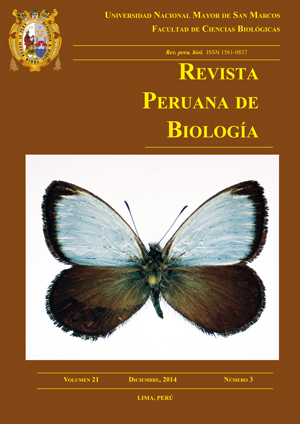Ecología de los cambios de cobertura del paisaje de glaciares de montañas tropicales
DOI:
https://doi.org/10.15381/rpb.v21i3.10900Palabras clave:
biogeografía, cambio climático, glaciares, uso de la tierra/cambio de cobertura, montañas tropicales, Andes.Resumen
Las montañas tropicales incluyen una singular diversidad biológica sujeta a las numerosas consecuencias del cambio climático global, exacerbado por concurrentes cambios socio-económicos. Los glaciares están en un balance negativo de su masa, promoviendo la exposición de los suelos a la colonización primaria, y alterando pantanos y riachuelos en las partes bajas. Revisiones de las tendencias actuales y predicciones sugieren que las especies de alta montaña sufrirían una reducción en las áreas de hábitats abiertos, debido al incremento en la cobertura de plantas leñosas, acompañado por los cambios en el uso del paisaje causados por agricultores y pastores a lo largo de las gradientes ambientales en las montañas tropicales. Es necesaria la investigación de las consecuencias en la biodiversidad y en los ecosistemas por causados por los cambios sucesionales, incluyendo los efectos directos del retroceso de los glaciares y las consecuencias indirectas de la acción combinada de factores sociales y ecológicos que ocurren en altitudes inferiores. Las áreas protegidas en las altas montañas usadas en la conservación de la naturaleza o manejadas colectivamente por comunidades locales representan oportunidades donde puede integrarse investigación y planes de desarrollo que podrían proveer espacios ecológicos para los futuros desplazamientos de los rangos de distribución de las especies.
Descargas
Descargas
Publicado
Número
Sección
Licencia
Derechos de autor 2014 Kenneth R. Young

Esta obra está bajo una licencia internacional Creative Commons Atribución-NoComercial-CompartirIgual 4.0.
LOS AUTORES RETIENEN SUS DERECHOS:
a. Los autores retienen sus derechos de marca y patente, y también sobre cualquier proceso o procedimiento descrito en el artículo.
b. Los autores retienen el derecho de compartir, copiar, distribuir, ejecutar y comunicar públicamente el artículo publicado en la Revista Peruana de Biología (por ejemplo, colocarlo en un repositorio institucional o publicarlo en un libro), con un reconocimiento de su publicación inicial en la Revista Peruana de Biología.
c. Los autores retienen el derecho a hacer una posterior publicación de su trabajo, de utilizar el artículo o cualquier parte de aquel (por ejemplo: una compilación de sus trabajos, notas para conferencias, tesis, o para un libro), siempre que indiquen su publicación inicial en la Revista Peruana de Biología (autores del trabajo, revista, volumen, número y fecha).






